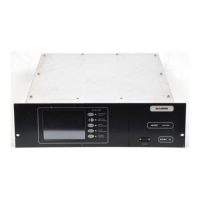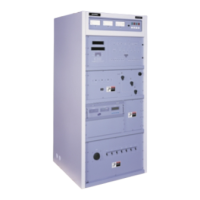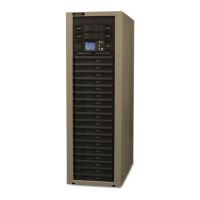if one particular pair is not drawing any
current.
WARNING
TURN THE TRANSMITTER OFF DISCON-
NECT PRIMARY POWER AND DIS-
CHARGE ALL HIGH VOLTAGE COMPO-
NENTS BEFORE REMOVING A FUSE
FROM A PA BOARD.
Pulling one fuse at a time to observe its
affect on the transmitter operation is one
way to isolate a non-working amplifier. If
no change is observed after removing a
particular fuse, then it is apparent that you
have isolated a bad amplifier.
Another approach is to remove transistors
to test them out of circuit as described in the
sectionon thePA modules.However, donot
operate the transmitter with any transistors
removed.
4.10. Troubleshooting AM Noise
When troubleshooting a noise problem, it
is important to know the level and fre-
quencyofthenoise.Knowingthefrequency
of the noise, it is possible to isolate the
source. The frequency of the noise may be
determined by connecting an oscilloscope
to the output of most distortion analyzers.
The scope display will be the total noise.
Measure the period of the noise with the
highest amplitude to determine the domi-
nant noise component.
An alternate method of determining the
noise frequency is by tuning a distortion
analyzer to it. A fully automatic distortion
analyzer cannot be used in this way. While
measuring the noise, switch the analyzer to
the THD mode. Then tune the frequency of
the analyzer for a dip in the meter reading
on the analyzer. Depending on the number
of significant noise frequencies affecting
the total noise figure, there may be more
than one dip in the analyzer reading. Fre-
quency of the noise may be read from the
analyzer frequencysettings. An audio spec-
trum analyzer may also be used for deter-
mining both noise frequency and
amplitude.
A listening test could be misleading since
the dominant noise component may actu-
ally be above or below the range of the
receiver or human hearing. Following are
some hints on solving various noise prob-
lems. These are categorized according to
frequency.
4.10.1. 50/60 Hz
This is a power line frequency and is not
usuallya significant noise componentinthe
GATES Series™ transmitter, due to the de-
sign of the power supplies. If investigating
a 50/60 Hz noise problem,first examine the
audio input wiring and make a measure-
ment with the audio cable going directly
from the audio generator to the transmitter
input terminals. This will eliminate any ef-
fectsofthe patchpanel wiringor noisefrom
other audio equipment in the system.
4.10.2. Audio Lines are Normally Balanced
That is, the audio line current does not
flow in ground. Grounding of either side of
the audio connectors can sometimes result
in noise. If it is determined that the 50/60
Hz noise is actually generated in the trans-
mitter, a bad rectifier is suspected. The
dominant noise frequency of a single phase
fullwaverectifiedpowersupply is normally
twice the power line frequency.
WARNING
ENSURE ALL VOLTAGE HAS BEEN RE-
MOVED AND THE SHORTING STICK HAS
BEEN USED TO REMOVEANYRESIDUAL
VOLTAGES BEFORE MEASURING THE
RESISTANCE OF ANY RECTIFIERS.
Use an ohmmeter to check each of the
rectifier diodes in the HV supply A19CR1,
A19CR2,A19CR3,A19CR4(alsoA19CR5
and A19CR6 if 3 phase supplied). Also
check the block type rectifier bridge
(A20CR1) in the +/-20 volt supply.
Anopenrectifierwouldalsoresultina
decrease in supply voltage. Also use an
oscilloscope to look for any evidence of
50/60 Hz noise in the power supplies. +/-20
volts and a high voltage supply sample ap-
pear on the PDM Generator, A15. +/-20
voltsisatthefusesofthePDMGenerator
and the high voltage supply sample is at
J1-7.
4.10.3. 100/120Hz
This is the principle noise frequency of all
the low level supplies. If 100/120Hz noise
is generated in the3-phase version,you will
also need to look for an imbalance having
to do with the 3 phase power supply.
Check the balance of the 3-phase AC pri-
mary power by using an AC voltmeter. Use
caution in this measurement and be sure to
measure between all AC legs.
It may also be necessary to check the high
voltage rectifiers and interconnecting wires
for loose or open connections.
4.10.4. 300/360Hz
In the standard GATES FIVE, which uses
a 3-phase HV supply, the principle power
supply noise component is 300/360Hz.
High noise of this frequency may indicate
open filter capacitorsor openan connection
in the highvoltagesupply.Anotherpossible
cause is a failure in the noise cancellation
circuit (U15) on the PDM Generator.
4.10.5. 60 kHz
This can only show up in a wideband
audio noise measurement or as a spurious
emission 60 kHz above or below the trans-
mitter operating frequency. This could be
caused by a significant imbalance in the
operation of the Polyphase system. Check
the PDM Fault indicators to see if any are
lit.
If any are lit, it will be necessary to trou-
bleshoot the PDM Generator (A15) or the
PDM Amplifiers (A6 thru A9) for pulse
width imbalance. A failure of a PDM Am-
plifier will also cause a substantial change
in power output.
4.10.6. RFI Noise on Audio
Check the audio wiring to the transmitter
for proper grounding of the shield at the
Interfaceboard. Also makesure thatneither
audio conductor is grounded. Grounding of
either side of an audio line takes away com-
mon mode rejection, which is essential in
preventing this type of noise.
The GATES Series™ transmitter is de-
signed with extensive RFI filtering on the
audio input circuitry and furthermore has a
solid state instrumentation input circuit
with high common mode rejection.
4-4 888-2314-001 Rev. T: Jan. 1996
WARNING: Disconnect primary power prior to servicing.
